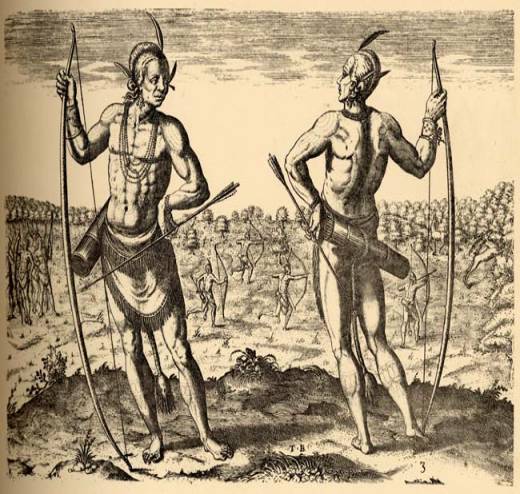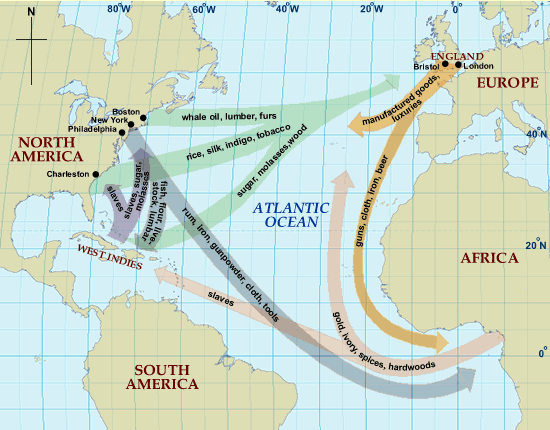
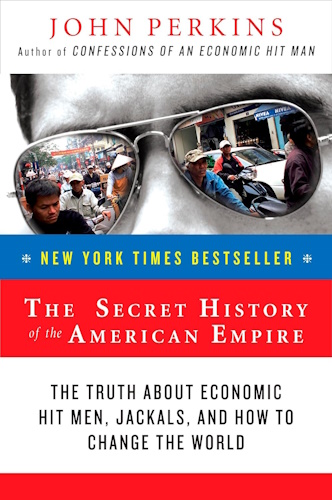

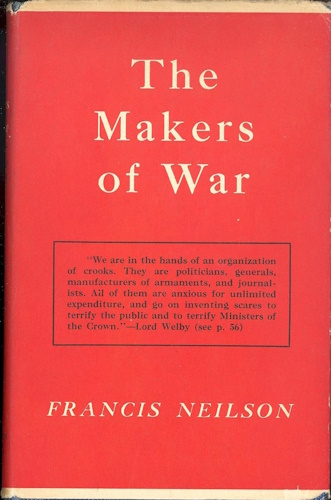

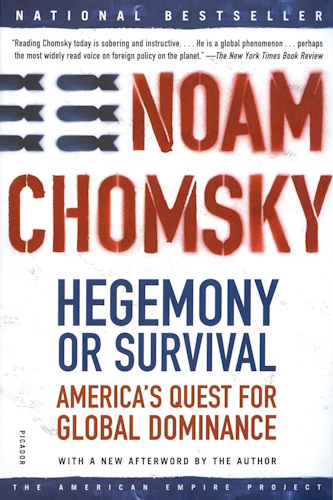



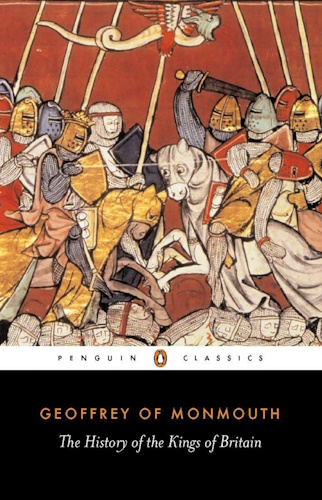

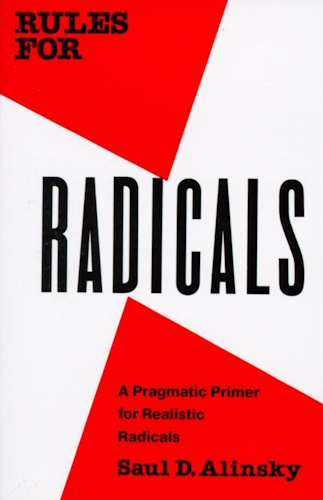

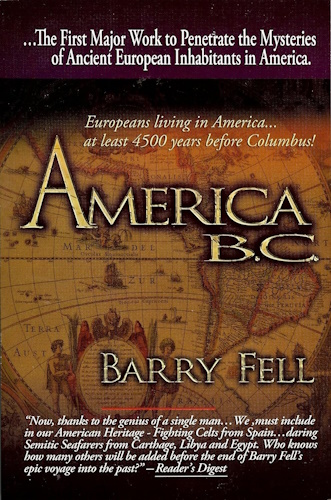

Whence & Pence
A Series
by
Douglas V. Gnazzo
January 6, 2005 - April 18, 2005
(Retrieved from archive.org)
![]()
Part 1: The Founding
January 6, 2005
THE EXPLORERS
So who discovered America? Was it Columbus, Lodge, or the Vikings? Maybe it was the Indians, now there's a novel idea. I doubt if we will ever know for sure, so maybe we should try an easier question: who settled the first Anglo Colony in America, for which a written record exists, and where was it located? Was it Plymouth Rock? Or Jamestown? What about Roanoke?
From whence have we come?
Modern archaeological techniques show that the Vikings had settlements here by the eleventh century. The first explorer that recorded his voyage to North America was Giovanni Caboto, known by the name of John Cabot. Cabot set aground in 1497, claiming North America for the English sovereign King Henry VII. Columbus was still sailing around the Caribbean looking for India, China or Japan – seems he wasn't too picky.
After floundering about and failing to find China, India or Japan, Christopher Columbus was running low on supplies with which to feed and pay his men. This was Columbus' first voyage with the three famous ships: Nina, Pinta, and Santa Maria. He originally landed on the Canary Islands, and then moved on to what is now called San Salvador. Columbus actually thought he had found India; hence he called the natives Indians. The year: 1492.
On his second voyage (1493-1496) Columbus sailed with a much larger force, 17 ships in all and about 1500 crewmembers. He established a home base at Hispaniola from which he discovered and named the Island of Dominica. From the island of Hispaniola, Columbus captured more than 1000 Taino Indians that became cargo or chattel that he sent to Spain, where they were sold as slaves.
On his third trip Columbus sailed further South to Trinidad and Venezuela. The year was 1498.
Columbus captured more Indian slaves than he could ship to Spain, so he decided to put them to work in mines and plantations that he and his family's business associates had started throughout the Caribbean.
During his fourth and last expedition, Columbus sailed to Panama, Honduras, Mexico and Santiago (Jamaica). By 1500 Columbus and his men had killed or sold into slavery 100,000 of the Taino Indians. Plantation owners now looked to America and Africa for slaves. If Columbus accomplished anything of merit, it was bringing sugar cane from Spain to the West Indies; however, this too was cursed by the white man's touch, as it was on sugar plantations that many of the slaves were imprisoned. Slavery is as old as the need of greed that calls it forth.
THE FIRST COLONY
Arthur Barlowe, 1550-1620
The First Voyage to Roanoke. 1584. The First Voyage Made to the Coasts of America, with Two Barks, wherein Were Captains M. Philip Amadas and M. Arthur Barlowe, Who Discovered Part of the Countrey Now Called Virginia, anno 1584. Written by One of the Said Captaines, and Sent to Sir Walter Ralegh, Knight, at Whose Charge and Direction, the Said Voyage Was Set Forth.
[Boston, Mass.]: [Directors of the Old South Work], [1898].© This work is the property of the University of North Carolina at Chapel Hill. It may be used freely by individuals for research, teaching and personal use as long as this statement of availability is included in the text.
In 1585, Sir Walter Raleigh first attempted to settle in Roanoke, which was part of the land called Virginia, in honor of Queen Elizabeth of England, who was referred to as the Virgin Queen. Roanoke is actually an island off the coast of North Carolina. So why did Raleigh bother to name the territory after Queen Elizabeth?
Thomas Hariot, 1560-1621, John White, fl. 1585-1593, illustrated by,
and Richard Hakluyt, 1552?-1616, translated by
A Briefe and True Report of the New Found Land of Virginia: of the Commodities and of the Nature and Manners of the Naturall Inhabitants: Discouered bÿ the English Colonÿ There Seated by Sir Richard Greinuile Knight In the ÿeere 1585: Which Remained Vnder the Gouerenment of Twelue Monethes, At the Speciall Charge and Direction of the Honourable Sir Walter Raleigh Knight Lord Warden of the Stanneries Who therein Hath Beene Fauoured and Authorised bÿ Her Maiestie and Her Letters Patents / This Fore Booke Is Made in English by Thomas Hariot seruant to the Aboue-Named Sir Walter, a Member of the Colonÿ, and There Imploÿed in Discouering.
[New York]: [J. Sabin & Sons], [1871].© This work is the property of the University of North Carolina at Chapel Hill. It may be used freely by individuals for research, teaching and personal use as long as this statement of availability is included in the text.
ROYAL CHARTERS
King Henry VIII and his daughter, Queen Elizabeth I, issued charters to settle the New World. One such charter was granted to Sir Walter Raleigh, on March 25, 1584. Sir Richard Grenville captained the fleet that brought the colonists to the New World. Thomas Harriot represented Sir Walter Raleigh's interests in the adventure, which were considerable.
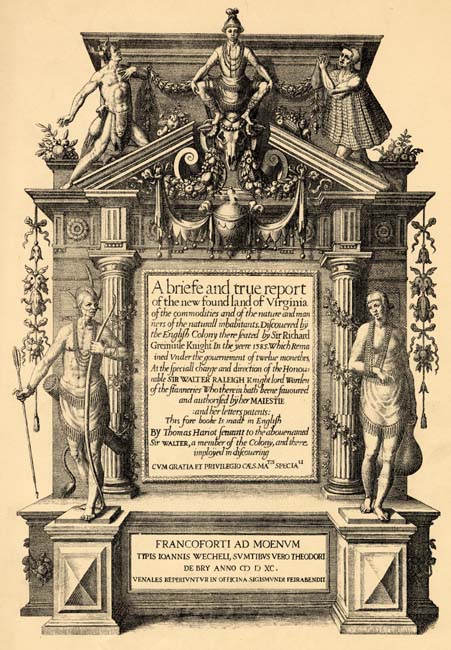
The King or Queen issued royal Charters by the authority of The Royal Prerogative. Charters were legal documents that decreed grants, particularly land grants, by the sovereign to his subjects.
"The king has a prerogative in all things, that are not injurious to the subject; for in them all it must be remembered, that the king's prerogative stretches not to the doing of any wrong," Sir Henry Finch
The power and authority of the King and Queen were almost absolute, as the following commentary by Blackstone shows:
"And, first, the law ascribes to the king the attribute of sovereignty, or pre-eminence. He is said to have imperial dignity, and in charters before the conquest is frequently styled basileus and imperator, the titles respectively assumed by the emperors of the east and west. His realm is declared to be an empire, and his crown imperial, by many acts of parliament, particularly the statutes 24 Hen. VIII. c. 12. and 25 Hen. VIII. c. 28; which at the same time declare the king to be the supreme head of the realm in matters both civil and ecclesiastical, and of consequence inferior to no man upon earth, dependent on no man, accountable to no man." Blackstone
As can be seen, these King guys were pretty powerful; about the only things they couldn't do was walk on water and raise the dead; as a matter of fact they seemed to have a pension for burying the dead due to their desire for conquest; and they also commissioned many a ship that ended up underwater. I guess nobody is perfect, not even Royalty – although they would prefer that we think otherwise.
Sir Francis Drake rescued the first group of settlers as they were experiencing hard times and were fast approaching the end of their rope. In 1587, another colony was left at Roanoke, but by 1590, when a supply ship that was long overdue finally arrived, it was discovered that colonists had all disappeared without a trace. This is the infamous "lost colony" whose fate to this day remains unknown.
The Arriual of the Englishemen
in Virginia.
"Then they brought vs to their village in the iland called, Roanoac, and vnto their Weroans or Prince, which entertained vs with Reasonable curtesie, althoug the wear amased at the first sight of vs. Suche was our arriuall into the parte of the world, which we call Virginia, the stature of bodee of wich people, they rattire, and maneer of lyuinge, their feasts, and banketts, I will particullerlye declare vnto yow."
A Weroan or Great Lorde of Virginia
JOINT STOCK COMPANIES
On April 10, 1606, James I of England issued a Charter for the colonization of the east coast of America. Two groups of investors were named in the Royal Charter: the Company of Adventurers and Planters of the City of London for the First Colony in Virginia, and the Company of Adventurers and Planters of the City of Bristol for the Second Colony.
This was the Virginia Company, which was a joint stock company of two different companies: the London Company and the Plymouth Company. Their charters were identical, but for two different regions of land. The First Virginia Charter contains some fascinating paragraphs that sum up de corp d'esprit of the moment:
"And more over wee doe grannte and agree for us, our heires and successors, that the saide severall Counsells of and for the saide severall Colonies shall and lawfully may by vertue hereof, from time to time, without interuption of us, our heires or successors, give and take order to digg, mine and searche for all manner of mines of goulde, silver and copper, as well within anie parte of theire saide severall Colonies as of the saide maine landes on the backside of the same Colonies; and to have and enjoy the goulde, silver and copper to be gotten there of to the use and behoofe of the same Colonies and the plantacions thereof; yeilding therefore yerelie to us, our heires and successors, the fifte parte onelie of all the same goulde and silver and the fifteenth parte of all the same copper soe to be gotten or had, as is aforesaid, and without anie other manner of profitt or accompte to be given or yeilded to us, our heires or successors, for or in respecte of the same."
"And doe, in like manner, grannte and agree, for us, our heires and successors, to and with the saide Thomas Hannam, Raleighe Gilberd, William Parker and George Popham, and all others of the saide Seconde Colonie, that wee, our heires [and] successors, upon petition in that behalfe to be made, shall, by lettres patentes under the Great Seale of Englande, give and grannte unto such parsons, theire heires and assignees, as the Counsell of that Colonie or the most parte of them shall for that purpose nomminate and assigne, all the landes, tenementes and hereditaments which shalbe within the precinctes limited for that Colonie as is afore said, to be houlden of us, our heires and successors as of our mannor of Eastgreenwich in the countie of Kente, in free and common soccage onelie and not in capite."
JAMESTOWN
You must admit, they could write a pretty serious legal document. And yet they were awfully nice, what with all the touchy-feely be houlden stuff going on. A group of about 100 settlers staked out their claims for the land that ran alongside of the James River, naming their settlement Jamestown – in Honor of King James who had granted them their Charter.
The King, flaunting his Royal Prerogative, later decided that he wasn't too thrilled with Sir Walter; and had Raleigh executed for treason to the Crown. As he placed his head on the block to be beheaded he remarked: "" Raleigh's greed and ambition has finely caught up with him.
CORPORATIONS IN ENGLAND
Definitions of Corporation Sole
"Corporation sole: A corporation consisting of one person only and his successors. An older concept of the status of a king or a bishop as incorporated in order to give to them and their successors legal capacities and advantages, particularly that of perpetuity, which they could not have in their natural capacities."
Ballantine's Law Dictionary
"A corporation sole is one consisting of one person only, and his successors in some particular station, who are incorporated by law in order to give them some legal capacities and advantages, particularly that of perpetuity, which in their natural persons they could not have had. In this sense, the sovereign in England is a sole corporation, so is a bishop, so are some deans distinct from their several chapters, and so is every parson and vicar."
Blacks Law Dictionary
INDENTURED SERVANTS
It was very hard and dangerous work to carve a home out of the wilderness in a strange and new land. But the "landed gentry" had help of course; they were called indentured servants. An indentured servant is an unfree labourer under contract to work, for a specified amount of time, for another person, often without pay, in exchange for accommodation, food, or free passage to a new land. After working for a number of years they were free to farm or take up a trade of their own. Sort of a euphemistic form of part time slavery. These indentured servants were so important and numerous that Article I, clause 3 of the Constitution even refers to them:
"Clause 3: Representatives and direct Taxes shall be apportioned among the several States which may be included within this Union, according to their respective Numbers, which shall be determined by adding to the whole Number of free Persons, including those bound to Service for a Term of Years…"
Bound to service – even has a nice ring to it. Very big hearted of our Founding Fathers to give such consideration to the poor folk, especially as most of them had slaves on their plantations. Seems it pays to keep the workforce happy and contented.
So just exactly was the hard work that all these indentured servants were needed for? Was it the planting, cultivating and harvesting of crops that could be sold for profit? What crops? In America, the aristocratic landed gentry deemed tobacco to be the most lucrative crop; on the nearby islands in the Caribbean sugar was the white mans gold; both crops brought to fruition by the labor of the black man for the white man.
Slavery started in the New World with the use of indentured servants, who performed the more strenuous labor and dangerous work. At first the merchants bought the indentured servants from England to the New World. Eventually the largest slave trade was from Africa to the Caribbean Islands. Many individuals made fortunes trading his fellow man; slavery providing the original money that many of the wealthiest family fortunes were based on: if not directly – indirectly by the labor provided.
THE CHARTER OF 1609
The King quickly figured out that the colonists, even with the help of an army of indentured servants, were not going to make a profitable undertaking of the settlement of Virginia. It was crucial to the Crown to maintain the Colonization of the New World, as not only were the vast resources of an as of yet untapped land extremely valuable, but the Crown also wanted its share of the trade routes across the Atlantic; as both Spain and Portugal had already made significant inroads in Central and South America.
The Crown decided to offer the businessmen of London a piece of the action, so they invited them to invest in the Company adventure, them being the Merchants Association of London. The Charter of 1609 was accordingly established. The Merchants had their own little set of rules that all had to play by, called Statuta de Mercatoribus or English Statutes of Merchants, 1283 & 1285.
LIVERY COMPANIES & THE MERCERS
Livery Companies are trade associations, originally known as guilds. They "regulated" trade. There were over a hundred Livery Companies in London. The Worshipful Company of Mercers was the preeminent company, incorporated under a Royal Charter in 1394. It was composed of the most important and wealthiest merchants that imported and exported goods in and out of London. As luck of the draw would have it, they just happened to own most of the ships used for transport.
THE CHARTER OF 1612
The Charter of 1612 limited the control of the London Company. However, the most important change was the reorganization of the Virginia Colony Government. The London Company continued to operate under the Charter of 1612 until Virginia became the King's Royal Colony, in 1624.
THE 13 ORIGINAL COLONIES
Soon others came from England to The New World. In 1620, the Mayflower brought over 100 settlers to the land now comprising Massachusetts. Because they had left port from Plymouth England, they named their new colony Plymouth. The London Company had granted them a patent, which indentured them to the Company for seven years. A set of rules was written by them and signed which is the famous "Mayflower Compact." The first sentence of the agreement contains some interesting wording, including "our dread Sovereign Lord King James."
New York followed in 1626, Maryland in 1633, Rhode Island and Connecticut in 1636, Delaware and New Hampshire in 1638, North Carolina in 1653, South Carolina in 1663, New Jersey in 1664, Pennsylvania in 1682, and lastly Georgia in 1732. Together they formed the original 13 colonies of America.
SLAVE TRADE
Sailing from the Canary Islands in 1493, Columbus' first commercial ventures involved sugar and the enslavement of the indigenous people of the Americas. Columbus introduced sugarcane to Hispaniola; and by 1498, he had shipped 1000 slaves to Spain. Following the lead of the father of chattel slavery in the Americas, the Portuguese and Spanish conquistadors enslaved the indigenous Americans and used them as field hands and laborers in the gold and silver mines.

John Hawkins was the first major slave trader from England. His reward for providing such fine goods for the Queen Mum was knighthood; his most telling coat of arms appears left. In 1567 Hawkins took along Sir Francis Drake on his voyage to trade slaves. Drake became another parasite of the slave trade. Sir Walter Raleigh was also involved in the trafficking of human flesh.
The contribution of slaves to the building of the nations of the Americas cannot and must not be underestimated or overlooked. This pestilence of evil had slaves working in every major New World venture: cultivating sugar in the West Indies; growing cotton and tobacco in North America; mining gold and diamonds in South America; and the building of cathedrals and fortresses across the land. Many were also sold into sexual slavery and bondage.
Man treating his fellow man as a beast of burden, a mere piece of property or chattel, is a sorrowful woe, a despicable blight that reaches into the recesses of the soul, to steal the light. The day of reckoning will find the scales of justice grossly displaced, many who are weighed in the balance will found to be wanting. The cost will be great, as hell will be paid as tribute to Lucre.
"Of every malice that earns hate in Heaven,
injustice is the end; and each such end
By force or fraud brings harm to other men."
Dante
THE ROYAL AFRICAN COMPANY

and was named after that part of the African
coast where most of Britain's gold supply came from.
In 1662 Parliament granted a charter to a newly formed company - The Company of Royal Adventurers Trading to Africa, which granted them authorization to participate in the slave trade. The charter granted exclusive rights to merchants from the city of London. The Company was not successful, so in 1672 a new company was formed - The Royal African Company. The merchants from London retained exclusive rights. Many powerful merchants such as Edward Colston became rich by trading slaves from Africa.
The Royal African Company transported an average of 5,000 slaves per year. King Charles II was a shareholder, continuing the Crown's involvement with slavery. It has been said, "Slavery is at the heart of the wealth of London." The slave traders and plantation owner's sway of influence over the City of London was very powerful: 15 Lord Mayors were shareholders in the Royal Africa Company by 1690.
The European Atlantic slave trade grew out of the ancient Black and Mediterranean Seas trade. The trafficking along the African coast was part of the transition from the Old World to the New World; including the enslavement of ones fellow man, which has been going on since the dawn of man. It has always been about trade routes and profits: whichever way, whatever means – to turn a pence.
They even had a special treaty about the slave trade – the Asiento Treaty of 1713 by which Spain gave Britain the exclusive right to supply the Spanish colonies with African slaves for the next 30 years. The Asiento Treaty laid the groundwork for the famous Treaties of Utrecht.
The transatlantic trade between England, The New World including the West Indies, and Africa formed what is referred to as the Triangular Trade Route. This trade route provided great wealth to those involved. However, just as Midas' touch turned on him and sealed his doom, so too has this fortune sealed the fate of the guilty.
"Hard and unequal is with wrath the strife,
Which makes us buy its pleasure with our life"
Cape Coast Castle was the headquarters of the English Royal African Company, eight miles along the coast from El Mina.
Estimates range between 9-11 million people being taken from Africa as slaves by European traders. Since the average loss during crossing the Atlantic was approximately 1/8 of all slaves, there are perhaps 1½ million Africans buried at the bottom of the Atlantic Ocean between Africa and the Americas. ‘Tis a heavy debt waiting to be paid, it's never about revenge – it's about the reckoning.
NEW FOUND WEALTH IN RHODE ISLAND
Rhode Island had developed a profitable trade with the entire Atlantic community, including England, the Portuguese islands, Africa, South America, and the West Indies, as well as other British mainland colonies of the New World. Although farming and agriculture were the main livelihoods, commercial trade flourished in Newport, Providence, and Bristol.
The most profitable trade was the slave trade, and Rhode Island was better at it then any other of the colonies. This traffic formed one leg of a triangular route that brought molasses from the West Indies to Rhode Island to make rum. The rum was then traded along the African coast for slaves. Once again, the white man's fortune was made by the black man's burden.
New Port slave traders captured approximately 60,000 slaves; an estimated 15 million were taken to the West in total. Elite families were involved, like Boylston and Faneuil from Boston and the Browns from Rhode Island, the founding benefactor of Brown University. All grew rich selling their fellow man into an oppressed life of bondage and servitude.
FINANCIERS IN HUMAN FLESH
Slave trading was a risky and expensive business. Ships were needed, provisions, sailors and the money to pay them with – all were in great demand. New banking houses were needed to offer credit to the slave traders. Alexander and David Barclay gladly offered such financing through Barclays Bank. Sir Francis Baring is said to have made his fortune as a slave dealer while only 16-years old. He then founded Barings Bank that supplied credit to the dealers in human flesh. Sir Francis was Chairman of The United British East India Company from 1792-1793.
The British South Sea Company was formed in the early 1700s to furnish African slaves to Spanish America. Some interesting names were recorded as owning stock: the Earl of Halifax, founder of the Bank of England; Daniel Defoe; Sir Isaac Newton; Jonathan Swift; 100 members of the House of Lords, and most members of the House of Commons.
The Royal family was not about to abstain from such a profitable business: the Duke of York branded his initials into the flesh of each of the 3000 slaves he owned – branding them like cattle or chattel. The infamous SOUTH SEA BUBBLE was the iniquitous cost exacted for trading with the devil.
"But when I turned, that's when you passed the point
to which, from every part, all weights are drawn."
Dante
To be continued in Part Two. But first a picture worth a thousand words:
Som Pictvre,
Of The Pictes
Which In The Olde
Tyme Dyd Habite One Part of The
Great Bretainne
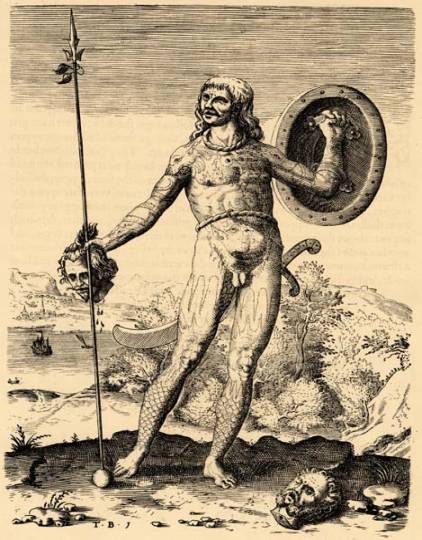
THE PAINTER OF WHOM I HAVE
had the first of the Inhabitans of Virginia, giue my allso these 5. Figures
fallowinge, fownd as hy did assured my in a oolld English cronicle, the which
I wold well sett to the ende of thees first Figures, for to showe how that
the Inhabitants of the great Bretannie haue bin in times
past as sauuage as those of
Virginia
![]()
© 2005 Douglas V. Gnazzo
![]()
![]()
![]()
Disclaimer:
Some material presented will contain links, quotes, ideologies, etc., the contents of which should be understood to first, in their whole, reflect the views or opinions of their editors, and second, are used in my personal research as "fair use" sources only, and not espousement one way or the other. Researching for 'truth' leads one all over the place...a piece here, a piece there. As a researcher, I hunt, gather and disassemble resources, trying to put all the pieces into a coherent and logical whole. I encourage you to do the same. And please remember, these pages are only my effort to collect all the pieces I can find and see if they properly fit into the 'reality aggregate'.
Personal Position:
I've come to realize that 'truth' boils down to what we 'believe' the facts we've gathered point to. We only 'know' what we've 'experienced' firsthand. Everything else - what we read, what we watch, what we hear - is what someone else's gathered facts point to and 'they' 'believe' is 'truth', so that 'truth' seems to change in direct proportion to newly gathered facts divided by applied plausibility. Though I believe there is 'truth', until someone representing the celestial realm visibly appears and presents the heavenly records of Facts And Lies In The Order They Happened, I can't know for sure exactly what "the whole truth' on any given subject is, and what applies to me applies to everyone. Until then I'll continue to ask, "what does The Urantia Book say on the subject?"
~Gail Bird Allen
![]()
![]()














-
Urantia Book, 44:0.11 - The Celestial Artisans
Never in your long ascendancy will you lose the power to recognize your associates of former existences. Always, as you ascend inward in the scale of life, will you retain the ability to recognize and fraternize with the fellow beings of your previous and lower levels of experience. Each new translation or resurrection will add one more group of spirit beings to your vision range without in the least depriving you of the ability to recognize your friends and fellows of former estates.
-
Princess Bride 1987 Wallace Shawn (Vizzini) and Mandy Patinkin (Inigo Montoya)
Vizzini: HE DIDN'T FALL? INCONCEIVABLE.
Inigo Montoya: You keep using that word. I do not think it means what you think it means. -
Urantia Book, 117:4.14 - The Finite God
And here is mystery: The more closely man approaches God through love, the greater the reality -- actuality -- of that man. The more man withdraws from God, the more nearly he approaches nonreality -- cessation of existence. When man consecrates his will to the doing of the Father's will, when man gives God all that he has, then does God make that man more than he is.
-
Urantia Book, 167:7.4 - The Talk About Angels
"And do you not remember that I said to you once before that, if you had your spiritual eyes anointed, you would then see the heavens opened and behold the angels of God ascending and descending? It is by the ministry of the angels that one world may be kept in touch with other worlds, for have I not repeatedly told you that I have other sheep not of this fold?"
-
Urantia Book, Foreword - 0:12.12 - The Trinities
But we know that there dwells within the human mind a fragment of God, and that there sojourns with the human soul the Spirit of Truth; and we further know that these spirit forces conspire to enable material man to grasp the reality of spiritual values and to comprehend the philosophy of universe meanings. But even more certainly we know that these spirits of the Divine Presence are able to assist man in the spiritual appropriation of all truth contributory to the enhancement of the ever-progressing reality of personal religious experience—God-consciousness.
-
Urantia Book, 1:4.3 - The Mystery Of God
When you are through down here, when your course has been run in temporary form on earth, when your trial trip in the flesh is finished, when the dust that composes the mortal tabernacle "returns to the earth whence it came"; then, it is revealed, the indwelling "Spirit shall return to God who gave it." There sojourns within each moral being of this planet a fragment of God, a part and parcel of divinity. It is not yet yours by right of possession, but it is designedly intended to be one with you if you survive the mortal existence.
-
Urantia Book, 1:4.1 - The Mystery Of God
And the greatest of all the unfathomable mysteries of God is the phenomenon of the divine indwelling of mortal minds. The manner in which the Universal Father sojourns with the creatures of time is the most profound of all universe mysteries; the divine presence in the mind of man is the mystery of mysteries.
-
Urantia Book, 1:4.6 - The Mystery Of God
To every spirit being and to every mortal creature in every sphere and on every world of the universe of universes, the Universal Father reveals all of his gracious and divine self that can be discerned or comprehended by such spirit beings and by such mortal creatures. God is no respecter of persons, either spiritual or material. The divine presence which any child of the universe enjoys at any given moment is limited only by the capacity of such a creature to receive and to discern the spirit actualities of the supermaterial world.
-
Urantia Book, 11:0.1 - The Eternal Isle Of Paradise
Paradise is the eternal center of the universe of universes and the abiding place of the Universal Father, the Eternal Son, the Infinite Spirit, and their divine co-ordinates and associates. This central Isle is the most gigantic organized body of cosmic reality in all the master universe. Paradise is a material sphere as well as a spiritual abode. All of the intelligent creation of the Universal Father is domiciled on material abodes; hence must the absolute controlling center also be material, literal. And again it should be reiterated that spirit things and spiritual beings are real.
-
Urantia Book, 50:6.4 - Planetary Culture
Culture presupposes quality of mind; culture cannot be enhanced unless mind is elevated. Superior intellect will seek a noble culture and find some way to attain such a goal. Inferior minds will spurn the highest culture even when presented to them ready-made.
-
Urantia Book, 54:1.6 - True And False Liberty
True liberty is the associate of genuine self-respect; false liberty is the consort of self-admiration. True liberty is the fruit of self-control; false liberty, the assumption of self-assertion. Self-control leads to altruistic service; self-admiration tends towards the exploitation of others for the selfish aggrandizement of such a mistaken individual as is willing to sacrifice righteous attainment for the sake of possessing unjust power over his fellow beings.
-
Urantia Book, 54:1.9 - True And False Liberty
How dare the self-willed creature encroach upon the rights of his fellows in the name of personal liberty when the Supreme Rulers of the universe stand back in merciful respect for these prerogatives of will and potentials of personality! No being, in the exercise of his supposed personal liberty, has a right to deprive any other being of those privileges of existence conferred by the Creators and duly respected by all their loyal associates, subordinates, and subjects.
-
Urantia Book, 54:1.8 - True And False Liberty
There is no error greater than that species of self-deception which leads intelligent beings to crave the exercise of power over other beings for the purpose of depriving these persons of their natural liberties. The golden rule of human fairness cries out against all such fraud, unfairness, selfishness, and unrighteousness.

